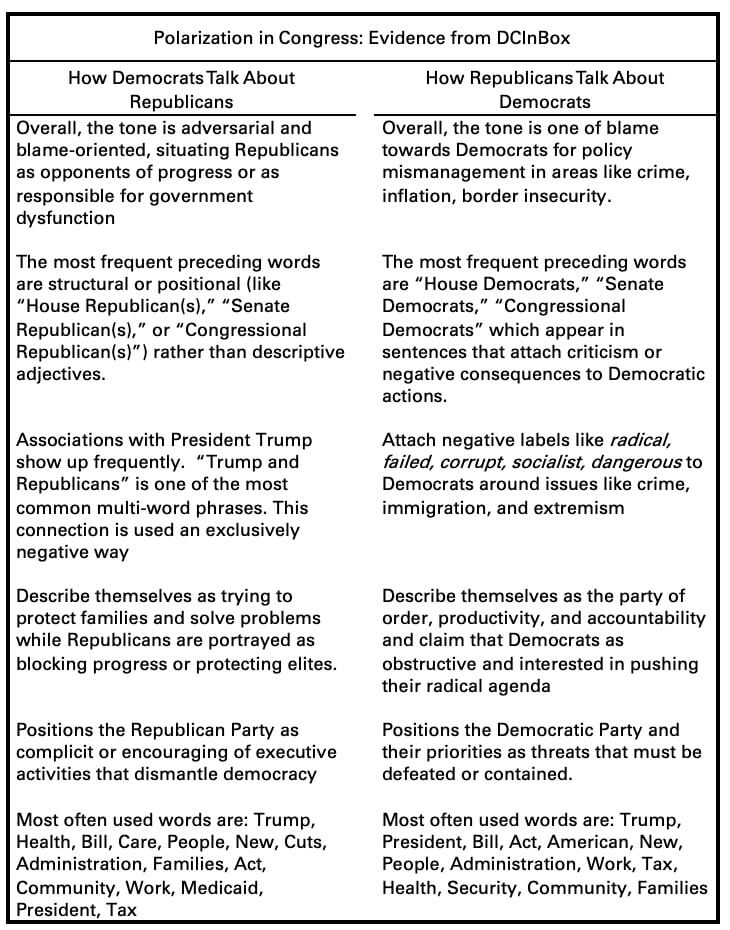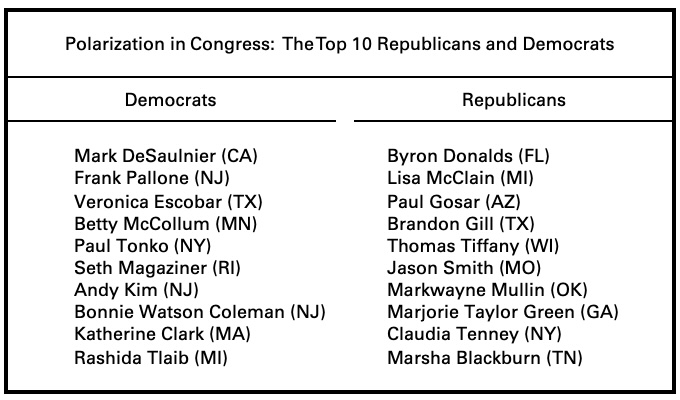What you need to know
Given the broad differences between Republicans and Democrats, there are many examples of strong policy disagreements. How can these disagreements be described – are they respectful of opponents or derogatory? The way that politicians talk about their opponents can shape how Americans view political opposition itself.
Our analysis of polarization is based on a unique database of all official congressional e-newsletters to constituents, maintained at DCinbox.com by Everything Policy’s Board Member and Content Lead Dr. Lindsey Cormack (Associate Professor of Political Science, Stevens Institute of Technology).
- Polarization refers to the magnitude of policy differences between Republicans and Democrats, and also to the language each side uses to describe the other.
- This policy brief uses a unique data source to examine examples of polarization in messages sent by members of Congress to their constituents.
What is polarization, and why does it matter?
Currently, the policy differences between Republicans and Democrats are as large as they have been since the end of World War II. However, theories of public opinion emphasize the degree of opposition as well as the tone and language used by each side to describe the other. Harsh and belittling descriptions can make it more difficult for politicians and the general public to engage in substantive dialogues about policy differences that may lead to meaningful outcomes. In the extreme, polarization can motivate political violence, such as the assassinations of Turning Point founder Charlie Kirk and Minnesota House Speaker Emerita Melissa Hoffman.
How often do legislators talk about members from the other party?
Members of Congress can send as many or as few official e-newsletters to constituents as they like. As of September 2025, 97% of all federal legislators (House Representatives and Senators) have set up the ability to send official e-newsletters.
Since the beginning of the 119th Congress which started on January 3, 2025:
- “Republican” has been mentioned in 2,050 e-newsletters sent by Democrats.
- “Democrat” has been mentioned in 1,317 e-newsletters sent by Republicans.
Historically, Republicans have sent more messages to constituents and discussed the other party more frequently than Democrats have. However, in the most recent Congress, Democrats have been sending more communications and referencing Republicans more often than they have in the past.
How does each party talk about the other?
The table below summarizes the main themes in Democratic and Republican messages about the other party.

Overall, the tone of Democratic and Republican messages are somewhat similar in that each side blames the other, though the reasons for blame are slightly different. Both share a core legislative vocabulary, and Trump dominates focus for each party. Looking across all congressional e-newsletters, there are many examples of polarizing language. Relatively few cases include members of one party talking favorably about their colleagues in the other party.
Are all members of Congress sending polarizing messages?
Between January and September of 2025 38% of all official e-newsletters sent from Democrats mention Republicans or the Republican Party. Conversely, 20% of all official e-newsletters sent from Republicans mention Democrats, the Democratic Party, or “the Left”. (The Left is a term used by congressional Republicans to mean the opposition; Democrats tend to label Republicans as Republicans instead of “the Right”.)
The top ten legislators from each party who have most often written about the other party in their newsletters are listed in the table below:

There are two interesting things about these lists. One is that almost all of the Democratic and Republican congressional leaders are absent from the list – the lone example is Democratic Party House Whip Katherine Clark. In addition, while some elected officials on the list are noted for having a national media profile (e.g., Rashida Tlaib and Marjorie Taylor Greene), most would be unknown to the average American.
The Takeaway
So far in the 119th Congress, when a politician from one party talks about the other, it is generally in negative terms.
A large majority of legislators from both parties do not talk about the other party at all in their official communications. Moreover, most of the elected officials with high levels of partisan mentions are not party leaders or have a national reputation.
The loudest voices are likely defining the tone of national politics as the data reminds us that most legislators are still talking about the work of governing and the priorities for their constituents, not just about their opponents.
Enjoying this content? Support our mission through financial support.
Further reading
Cormack, L. (2024). I’ve been studying congressional emails to constituents for 15 years – and found these 4 trends after scanning 185,222 of them. The Conversation. https://tinyurl.com/ms3mm4nf, accessed 10/6/2025.
Blum, R., Cormack, L., & Shoub, K. (2023). Conditional Congressional communication: how elite speech varies across medium. Political Science Research and Methods, 11(2), 394-401. https://tinyurl.com/373tt66c, accessed 10/6/2025.
Sources
DCInbox (2025) DCInBox: Official e-newsletters from every member of Congress. In one place. In real time. https://www.dcinbox.com accessed 10/21/25.
Cormack, L. (2017). DCinbox—Capturing every congressional constituent e-newsletter from 2009 onwards. The Legislative Scholar, 2, 27–34. https://tinyurl.com/2m4nunjh, accessed 10/6/2025.
Cormack, L. (2016). Extremity in congress: communications versus votes. Legislative Studies Quarterly, 41(3), 575-603. https://tinyurl.com/rfej5nrc, accessed 10/6/2025.
Contributors
Lindsey Cormack (Content Lead) is an Associate Professor of Political Science at Stevens Institute of Technology and the Director of the Diplomacy Lab. She received her PhD from New York University. Her research explores congressional communication, civic education, and electoral systems. Lindsey is the creator of DCInbox, a comprehensive digital archive of Congress-to-constituent e-newsletters, and the author of How to Raise a Citizen (And Why It’s Up to You to Do It) and Congress and U.S. Veterans: From the GI Bill to the VA Crisis. Her work has been featured in The New York Times, The Washington Post, Bloomberg Businessweek, Big Think, and more. With a drive for connecting academic insights to real-world challenges, she collaborates with schools, communities, and parent groups to enhance civic participation and understanding.
William Bianco (Research Director) is Professor of Political Science at Indiana University and Founding Director of the Indiana Political Analytics Workshop. He received his PhD from the University of Rochester. His teaching focuses on first-year students and the Introduction to American Government class, emphasizing quantitative literacy. He is the co-author of American Politics Today, an introductory textbook published by W. W. Norton, now in its 8th edition, and authored a second textbook, American Politics: Strategy and Choice. His research program is on American politics, including Trust: Representatives and Constituents and numerous articles. He was also the PI or Co-PI for seven National Science Foundation grants and a current grant from the Russell Sage Foundation on the sources of inequalities in federal COVID assistance programs. His op-eds have been published in The Washington Post, Indianapolis Star, Newsday, and other venues.









